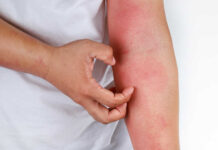
Acne occurs when the pores on the skin become clogged with oil and dead skin cells.
Contrary to popular belief, acne does not appear to be caused by dirt or uncleanliness. While the acne makes an appearance on the surface of your skin, the real cause lies just underneath.
Near the surface of your skin, attached to each tiny hair follicle, sebaceous glands produce an oily substance called sebum.
Sebum keeps your skin moisturized and protected, prevents it from drying out, and may also have antimicrobial properties.
But sometimes, sebaceous glands produce too much sebum, which can collect inside the hair follicle. This results in an oily blockage of dead skin cells that clog up your pores and cause acne vulgaris lesions, or as we commonly know them, pimples and zits.
What Can Trigger Acne?
There are a few different explanations for why sebaceous glands might produce too much pore-clogging oil.
Genetics may play a role. And the hormones associated with puberty can trigger the common reactions we know as teenage acne.
An interesting study from 2002 explored the possible societal influences by examining populations with little or no modern, western influence. In America and other “westernized” societies, acne affects 79-95% of adolescents and nearly 50% of adults over age 25.
When these researchers went to Papua New Guinea to examine the prevalence of acne, not one of the 1200 people (including 300 teenagers) from the Kitavan Islands was observed to have even a single case of acne. And in the Aché hunter-gatherers of Paraguay, after two years of regular checkups, again, no cases of acne were found.
This suggests that something in our environment, or most likely, our diets, is contributing to our nearly universal experience of acne. Those populations do not eat refined sugar, grains, milk, or dairy products, which Americans and other similarly acne-prone communities tend to eat a lot of.
High Glycemic Foods to Avoid
While many dietary factors may work together to trigger acne, one pathway, in particular, points the finger at high glycemic foods.
Foods with a high glycemic index are rapidly absorbed, increasing blood glucose and stimulating increased insulin signaling. Elevated insulin and insulin-like growth factor 1 (IGF-1) levels interact with androgen hormones and augment sebum production, leading to a higher risk for acne.
High glycemic foods include:
- bread
- rice
- cereals
- pasta
- potatoes
- pastries
- cookies, chips, crackers
- soda, fruit juices, sports drinks
If you want to limit your acne, you should probably avoid these foods as much as possible.
While not highly glycemic, milk has proteins and growth hormones that significantly contribute to IGF-1 signaling and may lead to increased acne.
On the other hand, the omega-3 fatty acids in fish may reduce inflammation and acne severity. Vegetables appear to have a beneficial effect on the hormones associated with acne and improve overall health and weight maintenance.
Instead of eating high glycemic foods, increase your fish intake, fruits, vegetables, and other plant-based foods.






















